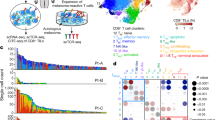Abstract
Epstein-Barr virus (EBV) is the aetiological agent of infectious mononucleosis and is associated with Burkitt's lymphoma and nasopharyngeal carcinoma1. The virus is harboured for life in all previously infected individuals2 and is apparently controlled by a population of EBV-specific memory T lymphocytes, specifically activated to recognize the functionally defined lymphocyte-detected membrane antigen3. Two types (A and B) of EBV have been identified that show DNA sequence divergence within the BamHl WYH region of the genome encoding the transformation-associated antigen, Epstein-Barr nuclear antigen 2 (EBNA 2) (ref. 4). To define the function of EBNA 2 in T-cell recognition, we have compared the ability of EBV-specific cytotoxic T-cell clones to distinguish between autologous B lymphocytes transformed by A-or B-type virus. We have now isolated both CD4 and CDS cytotoxic T-cell clones that recognize autologous A-type but not B-type transformed lymphoblastoid cell lines, thus providing the first evidence that EBV-specific T-cell recognition can be mediated by EBNA 2. As this antigen is not expressed in Burkitt's lymphoma5, this finding explains the failure of EBV-specific T-cell surveillance to eliminate the tumour.
This is a preview of subscription content, access via your institution
Access options
Subscribe to this journal
Receive 51 print issues and online access
$199.00 per year
only $3.90 per issue
Buy this article
- Purchase on Springer Link
- Instant access to full article PDF
Prices may be subject to local taxes which are calculated during checkout
Similar content being viewed by others
References
Epstein, M. A. & Achong, B. G. in The Epstein-Barr Virus: Recent Advances (ed. Epstein, M. A. & Achong, B. G.) 1–11 (Heinemann, London, 1986).
Nilsson, K., Klein, G., Henle, W. & Henle, G. Int. J. Cancer 8, 443–450 (1971).
Rickinson, A. B. et al. Cancer Res. 41, 4216–4221 (1981).
Dambaugh, T., Hennessy, K., Chamnankit, L. & Kieff, E. Proc. natn. Acad. Sci. U.S.A. 81, 7632–7636 (1984).
Rowe, M. et al. EMBO J. 6, 2743–2751 (1987).
Misko, I. S., Pope, J. H., Hutter, R., Soszynski, T. D. & Kane, R. G. Int. J. Cancer 33, 239–243 (1984).
Misko, I. S., Soszynski, T. D., Kane, R. G. & Pope, J. H. Clin. Immun. Immunopath. 32, 285–297 (1984).
Adldinger, H. K., Delius, H., Freese, U. K., Clarke, J. & Bornkamm, G. W. Virology 141, 221–234 (1985).
Townsend, A. R. M. et al. Cell 44, 959–968 (1986).
Thorley-Lawson, D. A. & Israelsohn, E. S. Proc. natn. Acad. Sci. U.S.A. 84, 5384–5388 (1987).
Rooney, C. M., Rickinson, A. B., Moss, D. J., Lenoir, G. M. & Epstein, M. A. IARC scient. Publs. 60, 249–264 (1985).
Zimber, U. A. et al. Virology 154, 56–66 (1986).
Young, L. et al. J. gen. Virol. (in the press).
Sculley, T. B., Walker, P. J., Moss, D. J. & Pope, J. H. J. Virol. 52, 88–93 (1984).
Author information
Authors and Affiliations
Rights and permissions
About this article
Cite this article
Moss, D., Misko, I., Burrows, S. et al. Cytotoxic T-cell clones discriminate between A- and B-type Epstein-Barr virus transformants. Nature 331, 719–721 (1988). https://doi.org/10.1038/331719a0
Received:
Accepted:
Issue Date:
DOI: https://doi.org/10.1038/331719a0
Comments
By submitting a comment you agree to abide by our Terms and Community Guidelines. If you find something abusive or that does not comply with our terms or guidelines please flag it as inappropriate.



